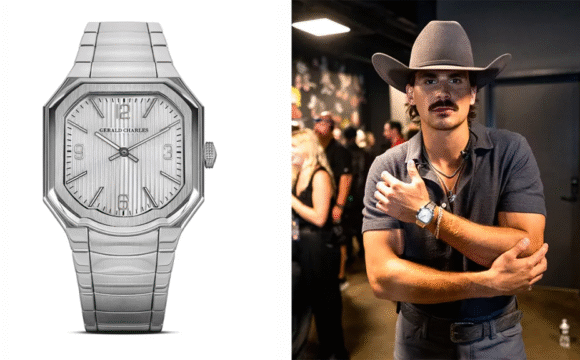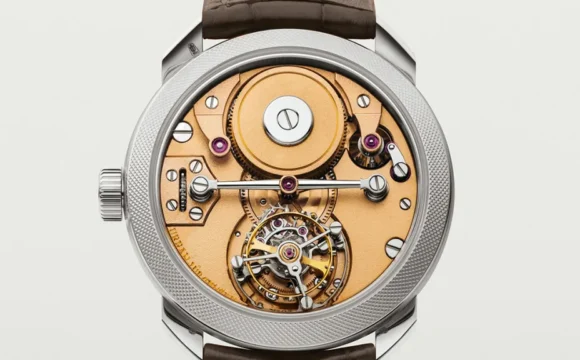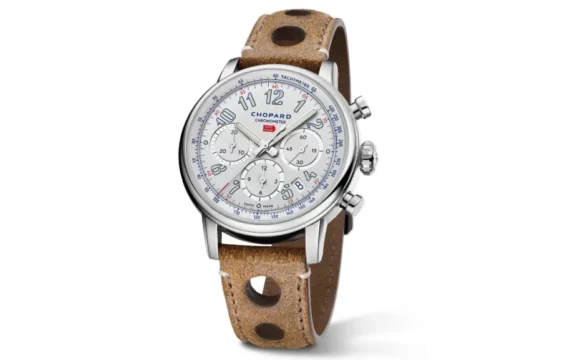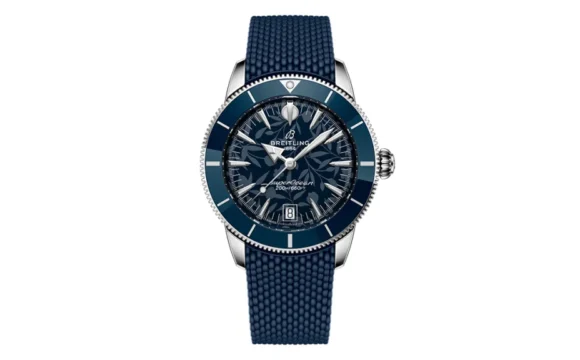นักสะสมนาฬิกามีความรู้สึกอย่างไรเกี่ยวกับสถานการณ์ของตลาดนาฬิกา? พวกเขามีความมองโลกในแง่ดีเกี่ยวกับอนาคตหรือไม่? ไม่พอใจเกี่ยวกับราคาหรือไม่? พวกเขาต้องการเห็นนาฬิกาที่มีความซับซ้อนมากขึ้นหรือลดลง?
ในช่วงฤดูร้อน Asher Rapkin และ Gabe Reilly ผู้ร่วมก่อตั้งร้านค้าออนไลน์ Collective Horology ตัดสินใจหาคำตอบ พวกเขาสร้างแบบสำรวจชื่อ Collective Voice และดำเนินการในเดือนมิถุนายนและกรกฎาคม โดยได้รับการตอบรับจาก 91 คน ซึ่งเป็นส่วนผสมของลูกค้าของ Collective และผู้ฟังของพอดแคสต์ Openwork Rapkin ตั้งข้อสังเกตว่านี่ถือเป็น “ตัวอย่างที่มีความหมายทางสถิติ”
“เราสำรวจผู้ตอบแบบสำรวจเกี่ยวกับความสนใจของพวกเขาสำหรับนาฬิกาปีต่อปี" Rapkin ซีอีโอของ Collective บอกกับ Robb Report “เราถามคำถามแบบเปิดเกี่ยวกับแบรนด์ที่สร้างแรงบันดาลใจให้พวกเขาและเหตุใด ในหลายระดับราคา และแบรนด์ที่พวกเขาเบื่อและเหตุใด และเราได้รับข้อมูลจำนวนมาก"
ด้วยความช่วยเหลือของ Collective Voice GPT ซึ่งเป็น ChatGPT ที่ปรับแต่งแล้ว Rapkin และ Reilly ได้ตีความผลลัพธ์และทำให้แชทสามารถใช้ได้กับแบรนด์ที่ Collective ขาย ซึ่งช่วยให้พวกเขาถาม AI เกี่ยวกับแบบสำรวจได้ตามต้องการ (Robb Report ก็ได้ลองใช้โมดูลนี้ด้วย)
“ข่าวดีคือ หากคุณมองอุตสาหกรรมจากภายนอก ความความสนใจในการสะสมนาฬิกาของนักสะสมระดับสูงเหล่านี้ยังคงค่อนข้างสูงมาก” Rapkin กล่าว เขาชี้ไปที่หนึ่งในผลการสำรวจที่สำคัญ: 72 เปอร์เซ็นต์ของผู้ตอบแบบสำรวจรู้สึกว่าอุตสาหกรรมอยู่ใน “ตำแหน่งที่แข็งแรง” หรือ “แข็งแรงมาก” ซึ่งส่วนหนึ่งเป็นเพราะความหลากหลายของแบรนด์และรุ่นที่มีให้เลือกสำหรับนักสะสม
ในทางกลับกัน 15 เปอร์เซ็นต์ของผู้ตอบแบบสำรวจอธิบายอุตสาหกรรมว่า “หยุดนิ่ง” และ 13 เปอร์เซ็นต์กล่าวว่าพวกเขาเชื่อว่าอุตสาหกรรม “กำลังถดถอย”
“บุคคลเหล่านี้กังวลว่าบางแบรนด์อาจประมาทเกินไป โดยพึ่งพาโมเดลที่เป็นตำนานมากเกินไป แทนที่จะผลักดันขอบเขตด้วยการออกแบบและนวัตกรรมใหม่ๆ" ตามสรุปผลการสำรวจที่จัดทำโดย Collective Voice GPT “แบรนด์หลายแบรนด์ดูเหมือนติดอยู่ในอดีต กำลังทำซ้ำโมเดลเก่าโดยใช้ความพยายามเพียงเล็กน้อยในการสร้างสรรค์หรือดึงดูดกลุ่มเป้าหมายที่อายุน้อยกว่า รู้สึกเหมือนพวกเขากำลังทำธุรกิจโดยไม่มีความเสี่ยงจนเกินไป"
Rapkin กล่าวว่าผู้ตอบแบบสำรวจแสดงความต้องการอย่างชัดเจนสำหรับการเสี่ยงในทุกระดับราคา ตั้งแต่ต่ำกว่า 5,000 ดอลลาร์ถึง 25,000 ดอลลาร์และสูงกว่า ในทางกลับกัน “การใช้โมเดลรุ่นเก่าๆไม่ได้ถูกมองอย่างดีและถือว่า ‘ขี้เกียจ’ หรือ ‘น่าเบื่อ'” รายงานสรุปกล่าว
Robb Report ได้สอบถามหัวข้อนี้เพิ่มเติมกับ Collective Voice GPT ซึ่งย้ำคำประเมินของ Rapkin “นักสะสมดูเหมือนจะดึงดูดแบรนด์ที่ผลักดันขอบเขตด้วยวัสดุใหม่ สุนทรียศาสตร์ที่ไม่ธรรมดา หรือความซับซ้อนที่สร้างสรรค์" บอทตอบ “นี่บ่งบอกถึงความต้องการแนวคิดใหม่ ๆ ที่ทันสมัยภายในอุตสาหกรรม แม้กระทั่งจากแบรนด์ที่อนุรักษ์นิยมแบบดั้งเดิม"
ข้อสรุปที่ใหญ่เป็นอันดับสามของการสำรวจนั้นเน้นเรื่องการกำหนดราคา โดย 64 เปอร์เซ็นต์ของผู้ตอบแบบสำรวจแสดงความกังวลเกี่ยวกับราคาที่เพิ่มสูงขึ้น
“มีความรู้สึกที่เพิ่มขึ้น—อย่างยุติธรรมหรือไม่—ว่าแบรนด์นาฬิกากำลังโก่งราคา และปฏิกิริยาคือการรวมกันของความโกรธ ความหงุดหงิด และความเหนื่อยล้า" ตามรายงานสรุปการสำรวจ “น่าสนใจที่สิ่งนี้ไม่ใช่เฉพาะชั้นคลาสหรือหมวดหมู่ใดหมวดหมู่หนึ่ง – ลูกค้าในตลาดนาฬิกา 1,000 ดอลลาร์รู้สึกเหมือนกันกับลูกค้าในตลาดนาฬิกาที่มีราคาสูงกว่า 25,000 ดอลลาร์"
มีความกังวลอีกด้านหนึ่งเกี่ยวกับราคาของผู้ตอบแบบสำรวจ “ไม่ใช่แค่ว่าผู้คนกังวลเกี่ยวกับนาฬิกาที่มีราคาแพง แต่พวกเขากังวลเกี่ยวกับคุณค่า" Rapkin กล่าว “โรคระบาดสร้างระดับความคาดหวังที่ไม่สมจริงซึ่งจุดชนวนการซื้อแบบบ้าคลั่ง เพราะในช่วงโรคระบาด คุณสามารถซื้ออะไรก็ได้ที่คุณสามารถขายเพื่อแลกกับเงินสดหรือทำเงินได้ หรืออย่างน้อยก็ไม่ขาดทุน ทุกวันนี้ ไม่เป็นความจริงอีกต่อไป และสิ่งนั้นทำให้ผู้คนเสียใจ ก่อนปี 2020 นั่นไม่ใช่เหตุผลที่ผู้คนซื้อนาฬิกาหรู อาการเมาค้างที่เรากำลังรู้สึกอยู่ในขณะนี้ทำให้หลายคนระมัดระวังมากขึ้นเกี่ยวกับการใช้เงิน"
สำหรับคำถามอื่นๆ ที่เราตั้งขึ้นในตอนต้นของเรื่องนี้ ผลลัพธ์ก็ชัดเจน
“แม้จะมีข้อกังวลบางอย่าง แต่ผู้ตอบแบบสำรวจส่วนใหญ่ก็ยังคงมองโลกในแง่ดีเกี่ยวกับอนาคตของอุตสาหกรรมนาฬิกา" ตาม Collective Voice GPT “หกสิบเจ็ดเปอร์เซ็นต์เชื่อว่าอุตสาหกรรมจะยังคงเจริญรุ่งเรือง โดยชี้ให้เห็นถึงความสมดุลระหว่างประเพณีและนวัตกรรมอย่างต่อเนื่องเป็นเหตุผลสำคัญสำหรับความมองโลกในแง่ดีของพวกเขา"
บอทยังบอกเราว่า “เมื่อถูกถามเกี่ยวกับกลไกที่พวกเขาชื่นชอบ ผู้ตอบแบบสำรวจเอนไปทางคุณสมบัติที่ใช้งานได้จริง โครโนกราฟและฟังก์ชัน GMT เป็นที่นิยมมากที่สุด โดยได้รับความชื่นชอบจาก 46 และ 39 เปอร์เซ็นต์ของนักสะสมตามลำดับ ในขณะที่กลไกที่มีความซับซ้อนอย่างมาก เช่น tourbillons สร้างความชื่นชมสำหรับฝีมือการผลิต มีเพียง 8 เปอร์เซ็นต์ของผู้ตอบแบบสำรวจที่กล่าวว่าคุณสมบัติระดับสูงเหล่านี้เป็นสิ่งที่พวกเขาแสวงหาอย่างจริงจัง” บอทอธิบาย
Collective Horology วางแผนที่จะทำการสำรวจทุกหกเดือน โดยครั้งต่อไปจะทำในฤดูใบไม้ผลิปี 2025 ก่อนหรือหลังงาน Watches and Wonders
จากบทความโดย Victoria Gomelsky

How are watch collectors feeling about the state of the watch market? Are they optimistic about its future? Dismayed about pricing? Do they want to see more complicated timepieces, or less?
Over the summer, Asher Rapkin and Gabe Reilly, cofounders of the online retailer Collective Horology, decided to find out. They created a survey, called Collective Voice, and fielded it in June and July, garnering responses from 91 people, a mix of Collective customers and listeners of their Openwork podcast. Rapkin notes that this constitutes, “a statistically meaningful sample."
“We surveyed respondents on their enthusiasm for watches year over year," Rapkin, Collective’s CEO, tells Robb Report. “We asked open-ended questions about brands that have inspired them and why, at multiple price points, and brands they have soured on and why, and we got a remarkable amount of data."
With the help of a customized ChatGPT bot, called the Collective Voice GPT, Rapkin and Reilly interpreted the results and made the chat available to the brands sold by Collective, allowing them to ask the A.I. anything they pleased about the survey. (Robb Report even gave the module a whirl.)
“The good news is that if you look at the industry from 10,000 feet, enthusiasm for watch collecting among these high-touch collectors remains pretty darn high," Rapkin says. He pointed to one of the survey’s key findings: 72 percent of respondents feel that the industry is in a “strong" or “very strong" position, thanks in part to the variety of brands and models available to collectors.
On the flipside, 15 percent of respondents described the industry as “stagnant," and 13 percent said they believe it is “in decline."
“These individuals worry that some brands have become complacent, relying too much on heritage models rather than pushing the envelope with new designs and innovations," according to a summary of the survey results provided by Collective Voice GPT. “Many brands seem stuck in the past, rehashing old models with little effort to innovate or appeal to younger audiences. It feels like they’re playing it too safe."
Rapkin says respondents expressed a clear desire for risk-taking across all price points, from below $5,000 to $25,000 and above. Conversely, “throwbacks are not being looked upon favorably, and are considered ‘lazy’ or ‘boring,’" said the summary report.
Robb Report further probed this topic with the Collective Voice GPT, which doubled down on Rapkin’s assessment. “Collectors seem to be gravitating toward brands that push the boundaries with new materials, unconventional aesthetics, or creative complications," the bot replied. “This suggests a hunger for fresh, cutting-edge ideas within the industry, even from traditionally conservative brands."
The survey’s third big takeaway centered on pricing, with 64 percent of respondents expressing concern about rising prices.
“There is a growing feeling—fair or otherwise—that watch brands are price gouging, and the reaction is a combination of anger, frustration, and exhaustion," according to the survey summary report. “Interestingly, this isn’t unique to any particular price class or category—clients in the market for $1,000 watches felt exactly the same as clients in the market for watches over $25,000."
There is another dimension to respondents’ concerns about prices. “It’s not just that people are concerned about expensive watches—they’re concerned about values," Rapkin says. “The pandemic created a level of unrealistic expectation that fueled a buying frenzy, because during the pandemic you could buy basically anything that you could sell for cash or make money on, or at least not take a loss. Today, that’s not true anymore and that messed people up. Prior to 2020, that’s not why people bought luxury watches. The hangover that we’re in right now has caused a lot of people to be way more cautious about what they’re buying."
As for the other questions we posed at the start of this story, the results were clear.
“Despite a few concerns, the majority of respondents are optimistic about the future of the watch industry," according to the Collective Voice GPT. “Sixty-seven percent believe the industry will continue to thrive, pointing to the ongoing balance of tradition and innovation as a key reason for their optimism."
The bot also tells us that, “When asked about their favorite complications, respondents leaned towards practical features. Chronographs and GMT functions were the most popular, favored by 46 and 39 percent of collectors, respectively. While highly intricate complications, like tourbillons, generate admiration for the craftsmanship involved, only 8 percent of respondents said these high-end features are something they actively seek out,” the bot explained.
Collective Horology plans to field the survey semiannually, with the next one planned for spring 2025, “right before or after Watches and Wonders," Rapkin says.
From the article by Victoria Gomelsky









